What Is Rosacea?
It’s an inflammatory skin condition that generally affects people over the age of 30. This can begin with redness on your nose, cheeks, chin, and forehead. Some people even get little bumps and pimples on these red parts of their face. This change in physical appearance can sometimes have a significant psychological impact. Any burning and soreness in your eyes may even be a sign of Rosacea. So, if you know the reason for the redness on your face or it bothers you or has gotten worse, talk to your doctor. Despite being a mysterious skin condition, controlling Rosacea and getting treatment can help your skin look and feel better.
What Causes Rosacea & Its Redness?
The principal cause of this skin condition is yet to be found. However, one thing is clear that it may not be an infection caused by bacteria that irritates the skin and makes it red in this case.
Though there are no clear causes for this skin conditions, there are triggers that can flare-up rosacea. For instance, alcohol does not cause facial redness but drinking alcohol when you have rosacea can aggravate the condition. It often flares when something causes the blood vessels in the face to expand, which causes redness.
6 Common triggers of Rosacea
1. Heat: External heat as well as heat generated in the body can trigger Rosacea as it causes the blood vessels to dilate which increases the blood flow to the skin surface.
2. Weather: Excess exposure to the sun generates heat in the body and can flare up facial flushing. UV rays can also affect sensory nerves which may dilate blood vessels to aggravate facial redness. Extreme cold weather, strong winds and excess humidity can also cause facial flushing as they activate dilation in blood vessels.
3. Diet: Foods and beverages that generate heat in the body are also potent triggers of Rosacea. Caffeine rich products, meats and spicy food are the possible culprits.
4. Exercise: Since exercise produces heat in the body, it affects the blood vessels and can result in instant flushing.
5. Stress: It's one of the leading causes of facial redness as it causes strain on the nerves and may cause expansion of blood vessels.
6. Genetics: In some cases, Rosacea seems to run in families especially of those people who have fair skin or blush easily.
Signs & Symptoms Of Rosacea
Everyone has a different skin type and so such skin concern can also vary substantially from one individual to another. However, there could be at least one of the potential signs and symptoms of rosacea which are still certain to appear in most of the cases. There are various secondary signs and symptoms which may subsequently develop. These symptoms may also develop beyond the face, most commonly on the neck, chest, scalp or ears.
9 Primary Signs of Rosacea
- Flushing: Frequent blushing or flushing is often the earliest sign of rosacea. In major cases this facial redness may come and go.
- Persistent Redness: The facial redness can be persistent which may resemble a blush or sunburn that doesn't go away.
- Bumps and Pimples: Small red solid bumps or pus-filled pimples which may resemble acne may often develop.
- Visible Blood Vessels: Those who have rosacea may even find small blood vessels become visible on their skin.
- Eye Irritation: Many people with rosacea have complained about irritated eyes that appear watery or bloodshot. This condition is known as ocular rosacea.
- Burning or Stinging: The pimples that appear may also give burning or stinging sensations. This may probably force scratching an itch. You can try these remedies to soothe itchy skin.
- Dry Appearance: The cheeks may turn rough, and thus appear to be very dry.
- Skin Thickening: Most men with rosacea find their skin becoming thick from excess tissue, most commonly on the nose.
- Plaques: The raised red patches which may develop without changing the surrounding skin are known as plaques.
Types Of Rosacea
Based on the symptoms, you can judge the type of your skin concern. You might experience characteristics of more than one subtype of Rosacea at the same time and there’s nothing unusual about it. This may or may not mean that Rosacea evolves from one subtype to another but like any other skin condition, each sign or symptom may progress from mild to moderate to severe if left untreated. This is why experts stress on early diagnosis to save you from complex treatments.
There are 4 subtypes of this skin condition depending on the common patterns or groupings of signs and symptoms which are:
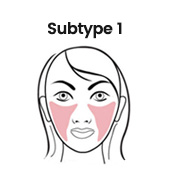
Erythematotelangiectatic
(Facial Redness)
Symptoms such as flushing and persistent facial redness with small blood vessels becoming visible in some patients. Stinging, burning, swelling and roughness or scaling may also occur.
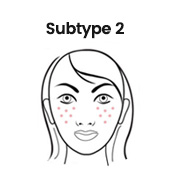
Papulopustular
(Bumps and Pimples)
Here, you can see bumps (papules) and/or pimples (pustules) in addition to persistent redness. Some of them may also experience raised red patches which are called plaques.
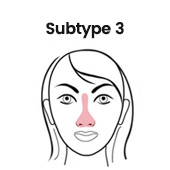
Phymatous
(Enlargement of the Nose)
An enlargement of the nose from excess tissue can also be an indication of Rosacea, known as rhinophyma. There could be thickening of the skin and irregular surface nodules on areas other than the nose as well.
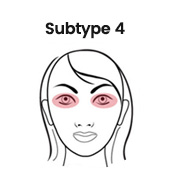
Ocular
(Eye Irritation)
Rosacea can even affect eyes in many patients, resulting in a watery or bloodshot appearance, irritation and burning or stinging. Eyelids may also become swollen, and eye styes are also common signs of this subtype.
Natural Rosacea Treatments & Solutions
There’s a lot you can do to help control or reverse signs and symptoms of rosacea. For a mild to moderate condition, you can use a combination of self-help measures and medication. Severe cases of Rosacea need help from a dermatologist.
Avoiding known triggers
There are medical therapies but sometimes you can improve the chances of recovery by merely identifying and avoiding lifestyle and environmental factors that may trigger flare-ups or intensify the condition. Identify those factors that lead to flare-up and try to avoid them. Remember, what triggered your rosacea may not have the same effect on someone else. As a first step against this skin condition, you can control the common triggers given above.
Creams and Serums
Natural medications which can be applied directly to the skin may be a great help to reduce spots and redness in rosacea. These products mainly use natural plant based extracts in their formulations that may offer a cooling effect on the redness, inflammation and irritation on your skin. Moreover, a water-based serum or cream could be more moisturising for dry skin and offer better absorption rates of the ingredients.
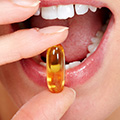
Oral Medications
As a quick and easy choice, many even choose tablets or capsules which can help clear up more severe spots. Oral medications that use natural ingredients that can help provide relief from Rosacea.
Tips To Handle & Prevent Rosacea
- Avoid strenuous exercise. Cardio exercises increase the core body temperature and lead to flushing. Shortening the duration of workouts, working out in air-conditioned spaces or exercising during a cooler time in the day are better options to control Rosacea symptoms.
- Consume a diet rich in leafy vegetables and fresh fruits. Green tea, salmon, legumes, turmeric, tomatoes and carrots are known to combat inflammation. Replacing refined vegetable oils with olive oil or coconut oil may also help improve skin inflammation and facial redness.
- Avoid sugar, processed and fried foods as it triggers inflammation and restrict the consumption of dairy products.
- Identify if certain makeup products or skin care creams are causing flare ups and avoid them.
- The facial redness and flushing can irritate the skin further when you step out in the sun. Using sunscreen regularly can help deal with this issue.
- Handling the facial redness and marks can be emotionally disturbing but it’s important to avoid stress as it aggravates Rosacea.
- Learn more about Rosacea and opt for natural treatments while being positive about the results. Look for natural stress relievers and regain your self-confidence to handle sudden facial flushing.
The Final Word
You can help keep the situation under control using the array of treatment options available that can play a significant role in the emotional aspects of the condition as well as the physical one. There’s a wide range of skin-friendly rosacea solutions to suit all skin types that can work wonders for your skin and charisma. It’s time to get rid of your anxieties and hold your head up high with fresh, uninflamed and calm skin.

